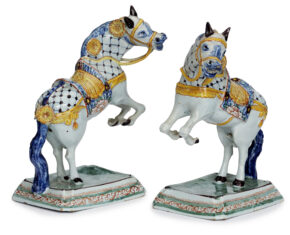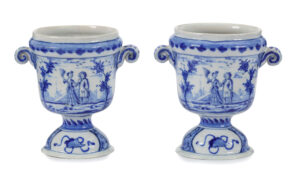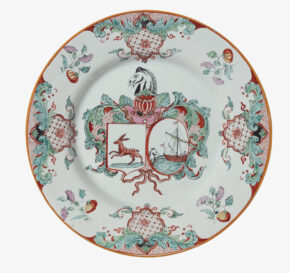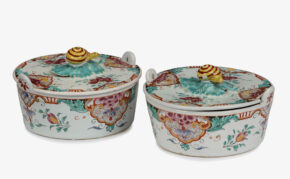
[popup_trigger id=”13756″ tag=”span”]![]() [/popup_trigger]
[/popup_trigger]
Images on this website are licensed under a
Creative Commons Attribution-NoDerivs 3.0 Unported License.
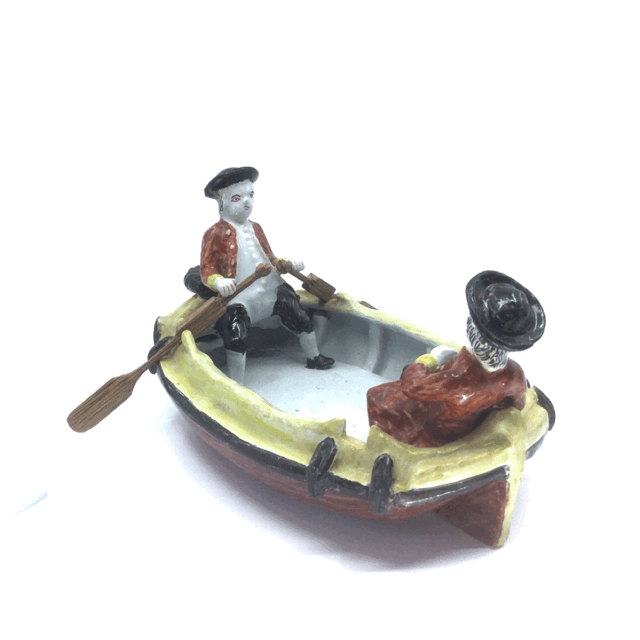
OBJECT
D1976. Polychrome Group of Two Gentlemen in a Boat
Delft, circa 1780
Modeled as two gentlemen sitting at either end of a rowing boat painted in yellow, iron-red and manganese, one holding two large wooden oars and wearing a manganese hat, a yellow-cuffed iron-red jacket and manganese breeches, the other seated and wearing a manganese hat, yellow-cuffed iron-red jacket and manganese breeches.
Length: 22.3 cm. (8.8 in.)
Note: The Netherlands has an abundance of waterways that have served as a thriving transportation system for centuries. The rivers and canals have always played an important role in Dutch life, and this polychrome group of two gentlemen in a boat perfectly encapsulates the cultural affection. When in the second half of the eighteenth century, the orient no longer functioned as the main inspiration source, the Delft potters focused on a more Western style. The subject of daily activities became the starting point for their ceramic wares: changes in interior design, eating habits, new fashion. Possibly following the German porcelain industry, which had set trends in the third quarter of the eighteenth century with the production of figurines, the Delft potters also made large numbers of imaginative figures and figurines in varying sizes around this period. Many of these objects were made to be displayed in glass cabinets or on etageres. Polychrome figural groups sitting in a boat are rather rare. Their rarity can be explained by the elaborate and expensive production process of these detailed objects. The smaller and more fragile details of this boat, such as the rowers and possibly the oars, were made in separate molds and added later. Whereas the larger European porcelain factories employed full-time designers to make the molds, the designs for these boats were probably created by the Delft potters themselves. The design may have been derived from porcelain examples, however no similar porcelain boats are known. Thus, it is more likely they originated from the Delft potter’s creativity. These brightly colored Delft objects found a ready market in the Netherlands, customers for whom German porcelain was too expensive or perhaps too refined. A number of factories must have been producing an enormous output. However, due to the elaborate and expensive production of these detailed objects, it must have been already costly at the end of the eighteenth century.
Similar examples: Although Delft potteries produced many miniature replicas of everyday objects, polychrome figural groups sitting in a boat are rather rare. Only eight other single groups of figures seated in a boat are known. A similar single group, in the collection of the Museum Prinsenhof, Delft (inv. no. PDA 39) is illustrated in Kievit and Klüver 2015, p. 171. Another example is illustrated in Lavino p. 146. Two other groups of the same model were sold at Sotheby’s Mak van Waay in 1967, October 31st, lot 1363 and at Sotheby’s in 1960, September 2nd, lot 34, at Glerum in 1995, June, 20th, lot 1048. Another very similar group of the same model was formely in the collection of Nelson and Happy Rockefeller. Another type of boat transporting cheese or butter is illustrated in Aronson 2003, p. 52, no. 50. A similar model was sold in Frederik Muller & Cie, 1958, lot 388. Another example is in the collection of the Rijksmuseum Twenthe (inv. no. BR0001 [R230]).


